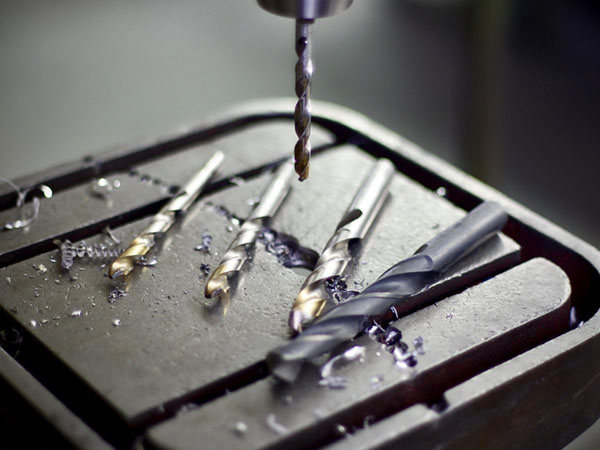
Tungsten Carbide vs. High-Speed Steel Drill Bits: A Selection Guide
In modern metalworking, the choice of drill bit material directly impacts both production efficiency and machining quality. As two of the most widely used materials, tungsten carbide (WC) and high-speed steel (HSS) often leave users uncertain about the best choice. This article draws on materials science principles and industrial test data to systematically analyze their intrinsic properties and application boundaries. By comparing key indicators such as hardness retention, thermal stability, and cost-efficiency, it offers practical selection strategies for various working conditions. Special solutions are provided for challenging scenarios such as composite material machining and interrupted cutting, helping technicians avoid selection pitfalls and build a scientific understanding of tool management.
1. Material Science Demystified (Layman’s Version)
1.1 A Microscopic World of Differences
- Tungsten Carbide Drill Bits – Think “Reinforced Concrete”
- Composed of hard tungsten carbide grains (like gravel)
- Bonded with cobalt metal (like cement)
- Ideal for high-pressure, continuous operations
- Diamond-like hardness (~HRC 90), perfect for stainless steel and cast iron
- Downside: Brittle – vulnerable to chipping upon impact

- High-Speed Steel Drill Bits – Think “Spring Steel”
- Interconnected carbide networks provide elastic support
- Vanadium-enhanced wear-resistant layer (like a protective shell)
- Tolerates sudden impact better
- Lower hardness (~HRC 65) but significantly tougher
- Suitable for general steel machining and less prone to breakage during accidental collisions

1.2 Thermal Resistance Test
| Temperature Range | Tungsten Carbide Performance | High-Speed Steel Performance |
|---|---|---|
| 20–300°C | Stable | Optimal working condition |
| 300–500°C | Starts oxidizing (needs coating) | Hardness drops ~15% |
| >500°C | Possible cobalt phase loss | Complete failure |
2. Key Performance Comparisons
2.1 Machining Efficiency
Case: Automotive Component – Stainless Steel Flange (10mm Hole Depth)
- Tungsten Carbide:
- 120 holes/hour
- Tool life: 800 holes
- 23% lower power consumption
- High-Speed Steel:
- 80 holes/hour
- Tool life: 300 holes
2.2 Material Compatibility Matrix
| Material Type | WC Suitability ★ | HSS Suitability ★ | Notes |
|---|---|---|---|
| 304 Stainless Steel | ★★★★★ | ★★☆ | Use WC with >10% cobalt content |
| 6061 Aluminum Alloy | ★☆☆ | ★★★★★ | Choose HSS with large helix angle |
| Fiberglass Board | ★★★★☆ | ☆☆☆☆☆ | WC with diamond coating is essential |
| Medium Carbon Steel | ★★★☆ | ★★★★☆ | HSS offers better cost-effectiveness |
2.3 Maintenance Cost Analysis
- Grinding Costs:
- WC: Requires diamond wheels (~$200 per grind)
- HSS: Standard grinding wheel (~$50 per grind)
- Refurbishment Cycles:
- WC: ~3 times
- HSS: ~5 times
3. In-Depth Problem Analysis
3.1 Why Tungsten Carbide Bits Chip Easily?
Top 3 reasons:
- Poor clamping precision (runout > 0.02mm is risky)
- Sudden feed changes (use constant-torque holders)
- Low coolant concentration (test methods provided at the end)
3.2 Short Tool Life of HSS Bits? Try This:
Solutions:
- Stepwise Coating Technology: Increases surface hardness by 30%
- Nano-edge Reinforcement: Patent CN2023XXX
- Custom Chip Flutes: Optimized helix angles for material-specific cutting
4. Real-World Case Studies
4.1 German Automotive Plant
- Issue: Tool life below 50 holes when drilling vermicular cast iron
- Solution: Custom WC drill (12% Co) + pulse coolant system
- Result: Life increased to 420 holes, unit cost reduced by 58%
4.2 Vietnamese Mold Shop
- Issue: Frequent tool changes due to multi-material machining
- Solution: HSS base + adaptive alternating coatings (AlCrN/TiN)
- Result: 70% improvement in versatility, 2/3 reduction in tool changes
5. Smart Selection Toolkit
5.1 Quick Mnemonic for Material Selection
- "Three Hards = WC, Three Variables = HSS"
- Three Hards:
- Hard materials
- High production volume
- High-precision equipment
- Three Variables:
- Mixed materials
- Harsh conditions
- Tight budget
5.2 Four-Step Quick Check
- Material hardness > 45 HRC? → Choose WC
- Daily output > 500 units? → Choose WC
- Equipment precision < 0.05mm? → Choose HSS
- More than 3 material types? → Choose HSS
6. Conclusion
Selecting the right drill bit material is all about balancing machining factors with precision. Tungsten carbide offers superior hardness and heat resistance, dominating in continuous machining of hard materials. High-speed steel, on the other hand, provides excellent toughness and economic value, thriving in mixed or unstable environments.
To make a wise choice, consider material characteristics, equipment precision, and production volume—and beware of relying solely on "hardness" or "cost" as deciding factors. As coating technologies and hybrid materials evolve, the performance boundaries between WC and HSS are being redefined. Only by adopting a dynamic evaluation mindset can you fully unlock the potential of your tooling strategy—and find the sweet spot where efficiency meets cost control.
OEM Capability
 We like to do design according to all the customers' requirements, or offer them our new designs. With strong OEM/ODM capabilities, we can fill your sourcing demands.
We like to do design according to all the customers' requirements, or offer them our new designs. With strong OEM/ODM capabilities, we can fill your sourcing demands. Categories
| HSS-PM Taps | HSSE-M42 Taps |
| HSSE / HSS Taps | Spiral Flute Taps |
| Straight Flute Taps | Spiral Point Taps |
| Multi-function Taps |
| Solid Carbide Drill Bits | Twist Drill Bits |
| Center Drill Bits | Indexable U Drills |
| Flat-end Milling Cutter | Ball Nose End Mills |
